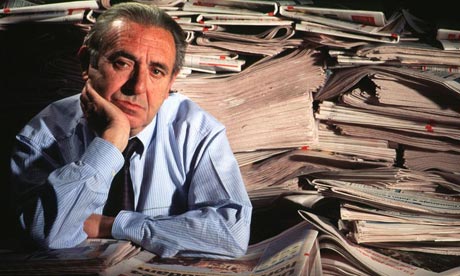
The photograph of his parents still hurt Josep Pernau each time he saw it
One of the most tragic photographs of the Spanish civil war shows a woman weeping over the bloodied corpse of her husband after GeneralFrancisco Franco's rightwing rebels had bombed the Catalan city of Lleida in 1937. The woman in the photograph was María Riu and the man was Gabriel Pernau. Their son, the newspaper editor, campaigner and columnist Josep Pernau Riu, has died aged 80.
Late in his life, Pernau's family said that this famous photograph by Agustí Centelles, Spain's answer to Robert Capa, still hurt Pernau each time he saw it. But he recognised, as a journalist, that the image told the story of Franco's aerial bombardments – carried out by aircraft belonging to his fascist counterparts Adolf Hitler and Benito Mussolini – in a powerful and vivid fashion. The civil war, the ensuing Franco dictatorship and the eventual transition to democracy on the general's death in 1975 all marked the life of Pernau.
He was born in Lleida – where Gabriel worked in a pharmacy and María was a housewife – and educated in the city's Marista school. He became a teacher first, working in country schools for three years before moving to Barcelona to study journalism. He rose through the ranks of a lowly paid and straitjacketed profession in the 1950s and early 1960s, when Francoism was at its most unforgiving and the civil war remained a fresh, divisive wound. By 1969 he had become deputy editor of one of the city's main newspapers, El Diario de Barcelona, which had been published – on and off – since 1792.
Three years earlier, Pernau and a dozen other journalists in Barcelona founded the Democratic Journalists' Group, part of a popular groundswell pressuring for change. In later years, up to a third of the city's journalists would be members. In 1974 he was appointed editor of El Diario, a job he held through the early years of the transition to democracy that saw Spaniards approve a new constitution at a referendum in 1978. Pro-democracy journalists in the last decade of Franco's life played a constant game of cat and mouse with the dictator's censors and press officials, seeking ways to tell the truth about what was happening within the regime.
Those who practised journalism in the early years of the transition ran the risk of violent reprisals from far-right thugs who wanted to turn the clocks back. It was a time when bombs went off – and people were killed – at El Papus magazine and the offices of El País. Pernau himself was constantly on the receiving end of such threats, which he shrugged off with humour.
A generation of ground-breaking female journalists have recalled that he treated them as equals in the newsroom of El Diario in the early and mid-1970s. He was replaced at El Diario in 1977 and went on to edit Destino magazine and the short-lived Mundo Diario.
He also presided over the Barcelona Press Association, where in 1992 he oversaw the writing of a code of ethics that banned the electronic manipulation of pictures and insisted on the separation of reporting and opinion. The code provided a model that was copied in other regions of Spain. Pernau became head of the Federation of Spanish Press Associations – successfully lobbying for legal recognition of journalists' rights to protect their sources.
Pernau was not given to delusions of grandeur. In later life, as a columnist at Barcelona's El Periódico de Catalunya and dean of the Catalan Journalists College, he received public recognition for his contribution to his profession. He was given both El País's Ortega y Gasset award and the Catalan government's Cross of San Jordi. He wrote several books, including his memoirs, a history of the fall of Catalonia at the end of the civil war, and an exploration of the corrosive impact of humour on Spain's dictatorship, and continued to write his column until 2009.
One of the greatest surprises of his journalistic life was to discover the original of the Centelles photograph of his mother and father. Centelles's son Octavi remembers watching Pernau discover the picture in the photographer's archive in 1988 while researching a documentary: "He stayed looking at the picture for a while and turned white. He almost could not speak, but eventually he said, 'That's my mother and that is my father.'"
Pernau is survived by his wife, Carme Mas, whom he married in 1962, and their children, Neus, Gabriel and Jordi.
• Josep Pernau Riu, journalist, born 10 December 1930; died 14 November 2011
No hay comentarios:
Publicar un comentario